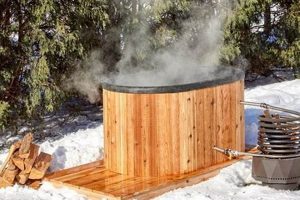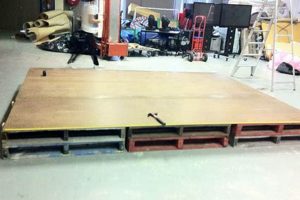A self-constructed carpentry surface, fashioned primarily from timber, provides a stable and customizable area for a variety of tasks. These structures are typically built by individuals, often utilizing readily available materials and basic construction techniques. The resulting platform allows for activities such as sawing, hammering, and assembling projects with greater precision and control.
Constructing one’s own customized platform offers several advantages. It permits adaptation to specific spatial constraints or functional requirements. Historically, these platforms represent a tradition of resourcefulness and practical skill. Furthermore, such projects often result in a cost-effective alternative to commercially manufactured models. The creation fosters a sense of accomplishment and ownership, enhancing the user’s connection to their workspace and projects undertaken.
The subsequent sections detail crucial aspects of planning, designing, and building a stable and functional surface. These aspects include material selection, joint construction, surface treatment, and techniques for incorporating essential features. Each element contributes to the overall durability and effectiveness of the final construction.
Essential Construction Recommendations
The following recommendations aim to enhance the structural integrity and usability of the self-constructed carpentry surface. Attention to these details ensures a durable and functional platform for various tasks.
Tip 1: Prioritize Material Selection: Choose hardwood, such as maple or oak, for critical structural components like legs and stretchers. Softwoods, like pine, are acceptable for the surface but may require additional reinforcement. The selection determines longevity and resistance to wear.
Tip 2: Employ Robust Joinery Techniques: Mortise and tenon joints, dovetail joints, or half-lap joints provide superior strength and stability compared to simple butt joints. Reinforce joints with wood glue and screws or dowels for maximum load-bearing capacity.
Tip 3: Ensure a Level and Stable Surface: A perfectly level surface is crucial for accurate work. Utilize shims or adjustable feet on the legs to compensate for uneven flooring. Regularly check and adjust as needed to maintain precision.
Tip 4: Incorporate Adequate Storage: Integrate drawers, shelves, or cabinets into the structure to maximize space utilization and organization. Proper storage keeps tools and materials readily accessible, improving workflow efficiency.
Tip 5: Apply a Protective Finish: Seal the wood with a durable finish, such as polyurethane or varnish, to protect against moisture, stains, and scratches. Multiple coats enhance durability and prolong the lifespan of the surface.
Tip 6: Optimize Ergonomics: Adjust the height to a comfortable working level to minimize strain and fatigue. A height slightly below the elbow is generally recommended for most tasks.
Tip 7: Reinforce the Frame: Add diagonal bracing to the frame for increased rigidity and resistance to racking. This is especially important for larger platforms or those intended for heavy-duty use.
Adherence to these construction recommendations results in a stable, functional, and enduring platform tailored to individual needs. Careful planning and precise execution ensures a valuable asset for any workshop.
The subsequent section will explore design modifications and customization options to further refine the surface to specific project requirements.
1. Stability
Stability is a fundamental prerequisite for a functional carpentry platform. Inadequate stability compromises the accuracy and safety of woodworking tasks. A wobbly or unstable surface increases the risk of material slippage, tool misdirection, and potential injury. The connection is causal: the stability of the platform directly affects the quality and safety of the work performed upon it. For example, attempting to plane a board on an unstable platform results in uneven material removal and a higher likelihood of tool chatter.
The absence of rigidity necessitates additional bracing, heavier construction, and often, repeated adjustments. A stable platform transfers force effectively, allowing the user to focus on the task rather than compensating for movement. Consider the process of hand-cutting dovetails; precision is paramount. Instability during this process leads to inaccurate cuts and a poorly fitting joint, rendering the assembly structurally unsound. Similarly, power tool operations, such as routing or sawing, demand a steadfast base to prevent deviations from the intended path, creating the risk of kickback or material damage.
Therefore, ensuring stability is not merely a desirable attribute but a foundational element. Solid construction techniques, including robust joinery and strategically placed bracing, are essential to mitigate movement and vibration. Achieving a high degree of stability enhances user control, precision, and overall safety, transforming the platform into a reliable and predictable work surface. Failure to prioritize stability negates the potential benefits of a self-constructed carpentry platform.
2. Work Surface Area
The available workspace, a critical dimension of a self-constructed carpentry platform, fundamentally dictates the scope and feasibility of projects undertaken. The physical dimensions of the surface establish hard limits on the size and complexity of workpieces that can be accommodated. A deficiency in surface area necessitates compromises, potentially including segmented construction, reduced project scale, or the awkward manipulation of oversized components. The relationship is straightforward: insufficient space directly impedes the efficiency and precision of woodworking operations. For example, assembling a large cabinet carcass on a diminutive surface requires continuous repositioning and support mechanisms, increasing the risk of misalignment and structural instability.
Conversely, an appropriately sized work surface allows for the unobstructed layout of project components, streamlined assembly, and the safe utilization of power tools. Ample space facilitates the pre-assembly of sub-components, enabling a more organized and efficient workflow. Consider the task of applying a finish to a large tabletop. A sufficient work surface area allows for even application without the need for constant repositioning, thereby minimizing the risk of blemishes or inconsistencies. Furthermore, a larger surface offers opportunities for integrated features, such as dog holes or clamping tracks, expanding the functional capacity of the platform. These integrated features augment the user’s ability to securely fasten workpieces, enhancing precision and control during critical operations.
In summary, the work surface area is a primary design consideration in self-constructed carpentry platforms. A properly dimensioned surface provides the necessary real estate for efficient workflow, precise assembly, and the safe utilization of tools. Selecting an inadequate surface area results in workflow inefficiencies, compromised precision, and limitations on project size. The consideration of anticipated project dimensions is crucial in establishing appropriate surface area parameters, thus maximizing the utility and longevity of the structure. Addressing this design element ensures a productive and comfortable workspace.
3. Material Durability
Material durability represents a key factor determining the lifespan and utility of a self-constructed carpentry platform. The selection of materials directly impacts the platform’s resistance to wear, environmental degradation, and structural failure under load. Appropriate choices ensure longevity and continued functionality.
- Wood Species Selection
The choice of wood species significantly influences the platform’s durability. Hardwoods like maple, oak, or beech offer superior resistance to abrasion and denting compared to softwoods like pine or fir. Areas subject to frequent impact or heavy loads, such as the legs and work surface, benefit most from hardwoods. A softwood surface, while potentially more cost-effective, necessitates careful finishing and may require periodic replacement. The material’s density and grain structure dictate its ability to withstand daily use and prevent premature degradation.
- Moisture Resistance
Wood is susceptible to moisture-induced warping, swelling, and decay. A durable material for a platform must exhibit inherent resistance to moisture or be treated to enhance its resistance. Kiln-dried lumber minimizes initial moisture content. Application of sealants, varnishes, or paints creates a protective barrier against water penetration. In environments with high humidity or potential water exposure, rot-resistant species like cedar or redwood offer a practical alternative to treated lumber. Moisture mitigation strategies are essential to preserving structural integrity.
- Joint Integrity
The durability of a carpentry platform relies not only on the material’s inherent properties but also on the strength and longevity of its joints. Well-executed joinery, such as mortise and tenon or dovetail joints, distributes stress effectively and prevents premature failure. The adhesives used in joint construction must also exhibit durability, maintaining their bond strength over time and under varying environmental conditions. Properly constructed and reinforced joints prevent racking, loosening, and eventual structural collapse. Joint failures are frequently the first sign of inadequate material durability.
Material durability, encompassing wood species selection, moisture resistance, and joint integrity, is critical for the longevity and functionality of a self-constructed carpentry platform. Compromising on material quality or appropriate treatment leads to premature degradation and reduced utility. Careful consideration of these factors ensures a stable, reliable, and lasting workspace.
4. Joint Strength
Joint strength is paramount in the structural integrity of any carpentry platform. The method of connecting individual wooden components directly dictates the overall load-bearing capacity and long-term stability of the structure. A poorly executed joint compromises the entire framework, creating a point of potential failure under stress. This weakness diminishes the effective utility of the platform. For instance, a platform constructed with simple butt joints, relying solely on fasteners for connection, is likely to exhibit significant racking and instability when subjected to heavy loads. This compromises the ability to perform precise woodworking tasks accurately.
Conversely, employing robust joinery techniques, such as mortise and tenon, dovetail, or lap joints, dramatically enhances the platform’s resistance to deformation and failure. These methods create a mechanical interlock between the joined components, distributing stress across a larger surface area. Reinforcement with adhesives and mechanical fasteners, such as screws or dowels, further augments joint strength. A well-constructed carpentry platform, utilizing strong joints, allows for the safe and efficient execution of tasks requiring substantial force, such as planing or hammering, without risk of structural collapse. The implementation of proper joinery reflects a direct investment in the long-term durability and safety of the work surface.
In summary, joint strength is not merely a construction detail but a fundamental prerequisite for a functional and reliable carpentry platform. Compromising on joinery quality results in a structure susceptible to failure, undermining its intended purpose. Prioritizing robust joint construction, utilizing appropriate techniques and materials, ensures a stable and long-lasting surface capable of withstanding the demands of woodworking tasks, thereby maximizing the utility and safety of the self-constructed carpentry platform.
5. Ergonomic Height
Ergonomic height is a critical design consideration in the construction of a carpentry platform. The vertical dimension of the work surface directly influences the user’s posture and biomechanics during operation. An improperly sized surface can lead to musculoskeletal strain, fatigue, and potential long-term injuries. Therefore, the height of the platform must align with the user’s anthropometric data and the typical tasks performed. A platform that is too low necessitates excessive bending, placing stress on the lower back. Conversely, a surface that is too high forces the user to elevate the shoulders, contributing to neck and shoulder pain. The impact is significant, affecting both user comfort and long-term physical well-being.
The optimal height is typically determined by the user’s stature and the nature of the work being undertaken. General guidelines suggest a height slightly below the elbow for tasks requiring downward force, such as planing or chiseling. For precision work, such as assembly or carving, a slightly higher surface may be preferable to facilitate closer visual inspection. Adjustable height platforms offer adaptability to accommodate a variety of users and task requirements. These incorporate mechanisms such as adjustable legs or lift systems, allowing for customized height settings. Furthermore, the integration of footrests or platforms can compensate for minor discrepancies in height, promoting a more neutral and comfortable posture. The consideration of task-specific requirements ensures maximum efficiency.
In summary, the ergonomic height of a self-constructed carpentry platform is a crucial factor in promoting user comfort, preventing injuries, and enhancing overall productivity. An appropriately sized surface mitigates musculoskeletal strain, allowing for prolonged work periods with reduced fatigue. Adjustable height platforms offer versatility and adaptability to accommodate individual needs and task requirements. Careful consideration of ergonomic principles during the design and construction phases ensures a workspace that supports both physical well-being and efficient workflow, maximizing the long-term value of the platform. Neglecting these principles poses significant health risks, underscoring the necessity of ergonomic integration in platform design.
6. Tool Storage
The incorporation of tool storage solutions within a self-constructed carpentry platform enhances both the efficiency and organization of the workspace. Integrated storage optimizes accessibility to frequently used tools, reduces clutter, and promotes a safer working environment. The design and implementation of such storage require careful consideration of tool types, frequency of use, and available space. The absence of appropriate storage can lead to lost tools, inefficient workflows, and an increased risk of accidents.
- Integrated Drawers
The inclusion of drawers within the carpentry platforms structure offers enclosed storage for hand tools, measuring devices, and fasteners. Drawers protect tools from dust and damage while maintaining close proximity to the work area. The size and configuration of drawers should accommodate the dimensions of commonly used tools. For example, a shallow drawer is suitable for chisels and marking gauges, whereas a deeper drawer can house hand planes and saws. Drawer placement near the users primary work zone maximizes accessibility.
- Open Shelving
Open shelving provides readily accessible storage for larger tools, such as power drills, sanders, and routers. Shelves can be integrated into the platforms frame or positioned underneath the work surface. The spacing between shelves should accommodate the height of the stored items. For instance, a shelf designed for power tools requires sufficient vertical clearance to allow for easy removal and placement. Open shelving facilitates quick tool retrieval and visual inventory management.
- Pegboard Systems
The attachment of pegboard panels to the sides or back of the carpentry platform offers customizable storage for frequently used hand tools. Pegboard allows for the arrangement of tools based on individual preferences and workflow patterns. Hooks, brackets, and containers can be used to organize tools of varying sizes and shapes. For example, a pegboard system can be configured to hold screwdrivers, pliers, and wrenches within easy reach. Pegboard systems promote tool visibility and efficient retrieval.
- Clamping Storage
Integrated storage for clamps is essential for maintaining an organized and efficient work area. Clamps are frequently used in woodworking and require dedicated storage solutions to prevent clutter and ensure accessibility. Options include clamp racks mounted to the platforms frame or designated storage compartments within drawers or cabinets. Clamp racks allow for the vertical storage of clamps, maximizing space utilization. Proper clamp storage prevents damage to clamp threads and ensures quick retrieval during project assembly.
Effective tool storage is an integral component of a functional self-constructed carpentry platform. The strategic integration of drawers, shelving, pegboard systems, and clamp storage enhances workflow efficiency, promotes tool organization, and contributes to a safer working environment. Neglecting tool storage considerations detracts from the overall utility and productivity of the platform. The careful planning and implementation of these features optimize the workspace for woodworking tasks.
7. Clamping Options
Clamping options represent an integral feature of a self-constructed carpentry platform, directly influencing the precision, efficiency, and safety of woodworking operations. The ability to securely fasten workpieces to the platform is essential for performing tasks such as sawing, routing, planing, and assembly. Inadequate clamping mechanisms compromise the stability of the workpiece, increasing the risk of material slippage, tool chatter, and inaccurate results. The incorporation of effective clamping solutions, therefore, is a critical design consideration. The absence of secure fastening contributes directly to lower quality output and potential user injury. For example, attempting to mortise a workpiece without proper clamping leads to inaccurate cuts and a higher risk of the material shifting during the operation.
Several clamping methods are commonly integrated into self-constructed platforms. Bench dogs and dog holes provide versatile clamping points, allowing the user to secure workpieces using holdfasts or specialized clamping hardware. Face vises, mounted to the front or end of the platform, offer robust clamping force for edge work and joinery. An integrated tail vise, in conjunction with bench dogs, provides a wide range of clamping options for larger workpieces. Clamping tracks, recessed into the work surface, allow for the use of T-track clamps, offering adjustable clamping positions along the length of the platform. The selection of appropriate clamping methods depends on the types of tasks typically performed and the size of workpieces commonly handled. For instance, a platform primarily used for small-scale joinery benefits from a versatile face vise and a series of strategically placed dog holes. A platform designed for larger projects may require an integrated tail vise and clamping tracks to accommodate wider workpieces.
In summary, clamping options are a foundational element of a functional carpentry platform. The ability to securely fasten workpieces to the surface enables precise and efficient woodworking operations. A variety of clamping methods, including bench dogs, vises, and clamping tracks, offer versatility and adaptability to different project requirements. Neglecting clamping considerations results in compromised work quality and an increased risk of injury. Careful planning and implementation of appropriate clamping solutions are essential for maximizing the utility and safety of a self-constructed carpentry platform, enabling the accurate and safe execution of woodworking tasks. Challenges in selecting and integrating clamping options typically involve balancing cost, complexity, and versatility to match specific project needs, all contributing to the overall value of the finished platform.
Frequently Asked Questions
This section addresses common inquiries and misconceptions regarding the construction and utilization of self-constructed carpentry platforms. The information provided aims to clarify design choices, construction techniques, and optimal usage practices.
Question 1: What is the minimum recommended size for a basic carpentry platform?
The minimum recommended dimensions for a basic carpentry platform are generally considered to be 48 inches in length and 24 inches in width. These dimensions provide sufficient surface area for a range of common woodworking tasks, including sawing, assembly, and light joinery. Smaller surfaces may be suitable for specialized tasks or limited workspace environments, but these dimensions offer a versatile foundation.
Question 2: What type of wood is most suitable for constructing a durable platform top?
Hardwoods such as maple, oak, or beech are typically preferred for platform tops due to their superior resistance to wear and denting. These materials provide a stable and durable work surface that withstands heavy use and resists deformation. Softwoods, like pine, can be used but may require additional reinforcement or a protective coating to enhance their durability.
Question 3: How can racking be prevented in a self-constructed platform frame?
Racking, or lateral instability, can be prevented by incorporating diagonal bracing into the platform frame. Diagonal braces provide resistance to twisting forces and maintain the structural integrity of the frame. These braces should be securely fastened to the legs and stretchers using screws, bolts, or mortise and tenon joints.
Question 4: What is the recommended height for a carpentry platform to minimize ergonomic strain?
The recommended height for a carpentry platform is typically slightly below the user’s elbow height. This allows for a comfortable working posture that minimizes strain on the back, shoulders, and arms. Adjustable height platforms offer the greatest versatility, accommodating users of different heights and task requirements. A platform height between 34 and 38 inches is generally suitable for individuals of average stature.
Question 5: How can integrated storage be effectively incorporated into a carpentry platform design?
Integrated storage can be effectively incorporated through the inclusion of drawers, shelves, and cabinets. Drawers provide enclosed storage for hand tools and fasteners, while shelves offer readily accessible storage for larger items. Cabinets can be used to store power tools and project materials. The placement and dimensions of these storage elements should be carefully planned to optimize accessibility and space utilization.
Question 6: What are the key considerations for integrating clamping options into a carpentry platform?
Key considerations for integrating clamping options include the selection of appropriate vise types, the placement of dog holes, and the incorporation of clamping tracks. A face vise provides versatile clamping force for edge work, while dog holes allow for the use of bench dogs and holdfasts. Clamping tracks offer adjustable clamping positions along the length of the platform. The choice of clamping methods should align with the types of tasks typically performed on the platform.
This FAQ section provides foundational guidance for designing and constructing a functional and durable carpentry platform. Addressing these common questions ensures a well-informed approach to platform construction.
The subsequent section will delve into advanced techniques and customization options to further refine the platform for specific project requirements.
DIY Wooden Workbench
The preceding exploration of the self-constructed carpentry platform elucidates key design elements, construction techniques, and optimal usage practices. Material selection, joint integrity, ergonomic considerations, integrated storage, and versatile clamping solutions represent foundational aspects of a functional and durable structure. Careful attention to these details ensures a work surface capable of withstanding the demands of diverse woodworking tasks.
The pursuit of a well-designed and skillfully constructed carpentry platform represents a significant investment in the craft of woodworking. The principles outlined herein serve as a foundation for future innovation and refinement. The ongoing development of advanced joinery techniques, sustainable material sourcing, and adaptable design modifications will further enhance the utility and longevity of these essential workspace assets. Continued exploration and adherence to established construction principles are critical to ensuring the continued value of a self-constructed carpentry platform.



![[DIY Guide] Easy DIY Wood Window Shutters You Can Build! The DIY Hub: Creative Crafts, Repairs & Life Hacks [DIY Guide] Easy DIY Wood Window Shutters You Can Build! | The DIY Hub: Creative Crafts, Repairs & Life Hacks](https://craftingdiycenter.com/wp-content/uploads/2025/07/th-3579-300x200.jpg)



